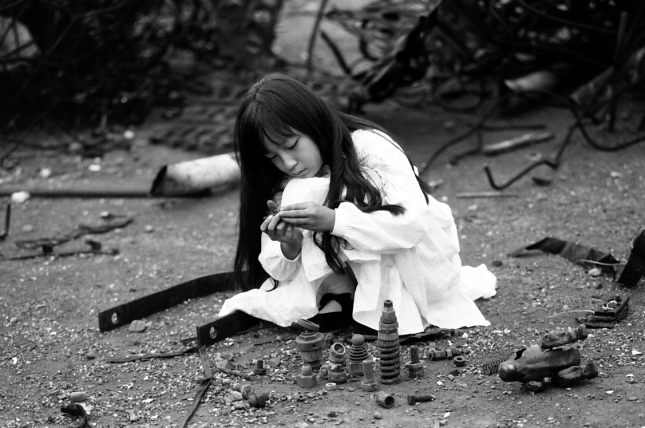Fe (1994) abandons genre to follow the plight of those living within a bleak reality similar to our own, before offering a scrap of hope for the future.
From its first sequence, Fe (1994)establishes a setting of eerie familiarity. Its location towers above the handful of characters, and stretches into shadow behind them. Abandoned factories, rusting metal, collapsed roofs, junkyards of glass and discarded items, smoke pluming from the peaks of mountainous chimneys. The site of Fe’s narrative is a metal labyrinth in its death throes. Clangs and scratches from unseen mechanisms shroud the characters as they traverse the ruins of a declining epoch. When not present, either a similarly oppressive silence fills the void, or the emotionally-fuelled compositions of musician Satoshi Isige, and filmmaker Kanji Nakajima, accompany the muted colours. The first character that speaks within Fe is introduced as miniature against the sky’s infinite backdrop. They declare themselves to be a painter, and tell of how they once painted a tree in this very location.
The Painter (performed by Eiji Maruyama) continues by saying they later watched the tree’s leaves fall to the ground, witnessed its branches become lifeless, and did nothing to intervene. After an undetermined amount of time, The Painter returns. They change the colour of the tree’s bark, make its branches larger and stronger, and the tree gradually changes shape. Fe’s story begins with The Painter’s own, and the confession that they have waited a thousand years to return again to this spot, and do a spot more painting. Carrying a case of tools, and an empty canvas, The Painter reaches a chair. There they sit, within a field of deserted metal sheets and dead trees, looking at Fe’s central area – a monolithic factory, sporting cloud-breaking smokestacks, and thoroughly entangled in pipes of assorted sizes.
The Painter is soon joined at the easel by a child. The Child (performed by Reina Oshibe) is a creator in their own right. They build structures from disused objects, and draw scenes of chalk in the omnipresent metal and concrete. Sitting in front of the blank canvas, The Painter tells The Child that they are waiting for petals to rain from the sky before they begin to paint. The remaining 50 minutes of Fe continues to present this sort of obscure dialogue, but also, static long shots, face-centered close ups, a non-traditional approach to film-sound, and an undeniably impressive locale. The combination of these elements produces a movie effectively balanced between narrative bleakness and visual beauty, perhaps best embodied by its final sequence. The overall tone of Fe, however, is hard to decipher.

Both its visual and its narrative ambiguity allows the movie to juggle between a number of possible themes. The Painter’s character, their failing health, and the near-intimate relationship they seem to have with their surroundings may be a personification of creativity’s consequences. The inevitable inheritance of the planet, and the responsibilities therein, are perhaps reflected in The Child’s presence, and their budding interest in creations of their own. The destructive plight of human history in its entirety may well be the focus of this movie. Or it could be that all of these impressions are intended to form a kaleidoscope of guilt, regret, and hope. Of course, if I were to hire a translator to ask Kanji Nakajima what their intentions were in creating Fe, the truth may be something else entirely.
Personally, I enjoyed Fe for its ambiguity. It captures a host of feelings, and does so without employing the familiar movie-making techniques. It’s a debut feature from a filmmaker I have never heard or read anyone else talking about, and so clearly had budgetary restrictions, yet the film-world feels gigantic. I’ve truly no idea how they went about any of the set decorating, or location management, during the production of this movie. Are there places like that in real life? I don’t know. Fe could almost have been captured on an alien planet, or centuries into the future, but it still strikes me as being fundamentally human. It tackles human problems, and human emotions. Frankly, it’s a challenging movie – a springboard for thought.
Now, this may sound silly, especially coming from someone who strives not to take movies too seriously (though the paragraphs above certainly evidence otherwise): I wonder if, in writing about Fe, do I now have a role in its existence? It was released 27 years ago, and there are but three reviews of it listed on IMDb. I think if somebody was to shout loud enough about it there would be an audience of creatives, environmentalists, and philosophers out there, ready to love this flick to bits. Of course, those who watch movies for light entertainment, or for a harmless escape from their every day, might not find Fe delivers the goods. Though, in honesty, a movie that can inflate my ego so tremendously I begin to think I could single-handedly deliver it to the masses, simply by writing about it, is perhaps best left out of the public consciousness.
Fe was released in 1994.

